Home / OsO4 (Osmium Tetroxide) for Dihydroxylation of Alkenes
Alkene Reactions
OsO4 (Osmium Tetroxide) for Dihydroxylation of Alkenes
Last updated: March 21st, 2025 |
Osmium tetroxide, OsO4
- Osmium tetroxide (OsO4) is a useful reagent for the dihydroxylation of alkenes
- The products of these reactions are 1,2-diols (“vicinal” diols), where the two C-O bonds are formed on the same face of the alkene via a concerted mechanism.
- Dihydroxylation of alkenes with OsO4 is functionally equivalent to dihydroxylation with cold, basic KMnO4.
- OsO4 does not dihydroxylate alkynes!
- The vicinal diols can subsequently be cleaved with NaIO4 providing products that are eqivalent to those obtained through ozonolysis.

Table of Contents
-
- Osmium Tetroxide, OsO4 And The Dihydroxylation of Alkenes
- The Mechanism for Dihydroxylation of Alkenes With OsO4
- Predicting the Stereochemistry of Dihydroxylation Products
- OsO4 vs KMnO4 As A Reagent for Dihydroxylation
- Catalytic OsO4 Using Stoichiometric Oxidant
- Reactions of 1,2-Diols – Oxidative Cleavage With NaIO4
- Summary
- Notes
- Quiz Yourself!
- (Advanced) References and Further Reading
1. Osmium Tetroxide, OsO4 And The Dihydroxylation of Alkenes
Osmium tetroxide (OsO4) is a very useful reagent for the dihydroxylation of alkenes [Note 1] . In this reaction,
- A C-C (pi) bond is broken
- Two C-O bonds form on adjacent carbons
- The two new C-O bonds are delivered syn , which is to say, on the same face of the alkene.
For example, the reaction of cyclohexene with OsO4 gives exclusively cis-cyclohexan-1,2-diol, with none of the trans diol formed.
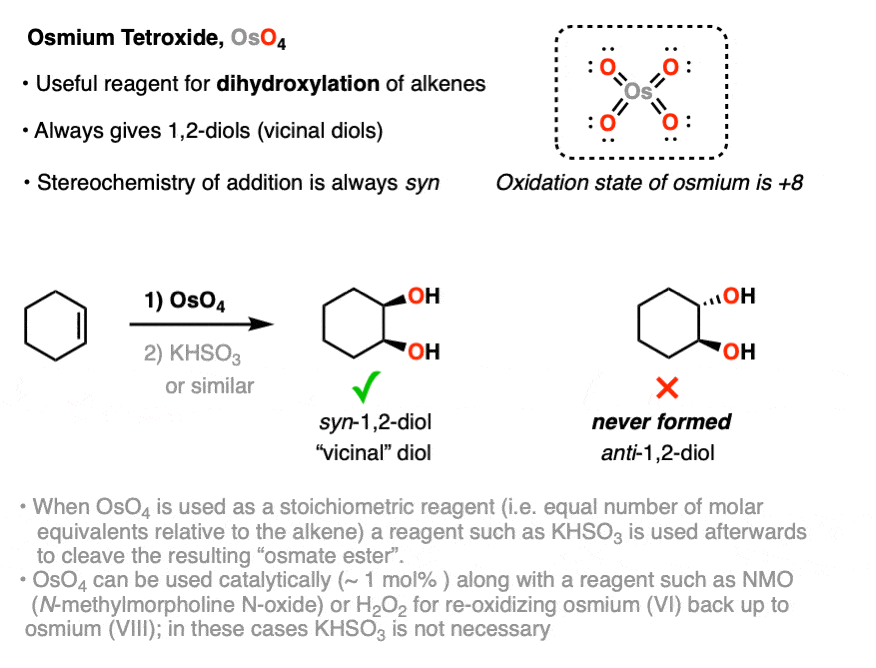
Since we are breaking a C-C bond and forming two C-O bonds, this is an example of an oxidation reaction (See article: Oxidation and Reduction in Organic Chemistry)
Two alkenes that differ only in their configuration (e.g. the stereoisomers cis– and trans– pent-2-ene) will result in products that are themselves stereoisomers.
This fits the definition of a stereospecific reaction, as per IUPAC. (See article – Stereoselective and Stereospecific Reactions)

Chiral molecules with exactly opposite (R,S) designations are enantiomers. Chiral molecules that share the configuration at at least one chiral center and differ at the configuration of another chiral center will be diastereomers. For more, see article: Types of Isomers)
Note that in each case the two new C-OH bonds form on the same face of the alkene.
2. The Mechanism for Dihydroxylation of Alkenes With OsO4
The mechanism of alkene dihydroxylation is a concerted cycloaddition reaction where the C-C pi bond combines with two Os=O bonds to give a five-membered ring structure known as an osmate ester. (Note that in the osmate ester the Os is in the +6 oxidation state as opposed to the +8 oxidation state found in OsO4)
This concerted mechanism nicely accounts for the cis stereochemistry observed in the dihydroxlyation of cyclohexene.

Osmate esters are fairly stable products and can be isolated. [Note 2] However, since we are generally much more interested in the diol, a reagent such as potassium bisulfite (KHSO3) or sodium bisulfite (NaHSO3) is commonly used to break the Os-O bonds and liberate the diol.
Just a heads-up – in introductory courses, this second reagent may or may not be included. It purpose is just to get rid of the osmium.
(It is much more common nowadays to use catalytic OsO4 and a stoichiometric amount of an oxidant such as N-methylmorpholine N-oxide (NMO) or H2O2 to regenerate OsO4 from the Os(VI) species. In these cases, KHSO3 is not needed. See section below.)
As a fairly electron-poor reagent, reactions with OsO4 increase in rate as the alkene becomes more electron-rich.
For practical purposes, this means that
- reaction rates generally increase with increasing substitution on the alkene ( tetrasubstituted (fastest) > trisubstituted > disubstituted > monosubstituted (slowest)
- reaction rates generally decrease if the alkene is attached to electron-withdrawing groups such as carbonyls
It’s possible to selectively dihydroxylate an electron-rich alkene in the presence of other alkenes. For a few examples, see Note 3 below.
3. Predicting The Stereochemistry Of Dihydroxylation Products
cis– and trans- alkenes can be each be prepared from alkynes, depending on the reagent(s) used for reduction.
- Alkynes treated with sodium (Na) in ammonia (NH3) gives trans-alkenes. (See article – Partial Reduction of Alkynes Using Na/NH3)
- Alkynes treated with Lindlar’s catalyst (palladium made less active through the addition of lead and quinoline) in the presence of hydrogen gives cis-alkenes (See article – Lindlar’s Catalyst)
Why is this important right now?
Well, since cis– and trans– alkenes give dihydroxylation products that are stereoisomers of each other, dihydroxylation reactions provide great fodder for exam questions that challenge your understanding of stereochemistry.
See if you can answer this classic quiz question:
 Click to Flip
Click to Flip
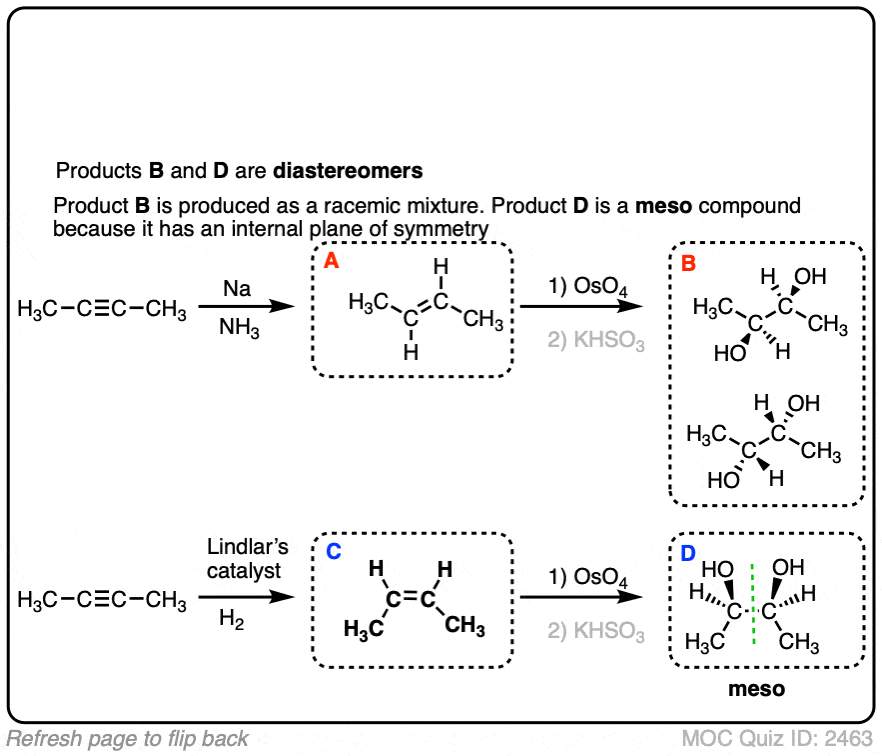
For a refresher on solving these kinds of stereochemistry problems, see article – Enantiomers, Diastereomers or the Same?
Just as important as determining the stereochemistry of products is being able to work backwards from the products of dihydroxylation to the starting alkenes.
This is more challenging with linear (as opposed to cyclic) products, since it will require that you successfully perform a bond rotation.
See if you can work backwards from this diol to the starting alkene:
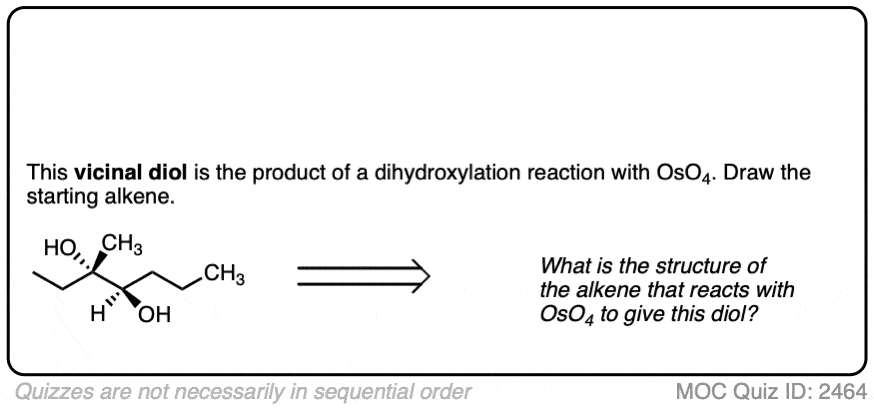 Click to Flip
Click to Flip

Here is a similar example:
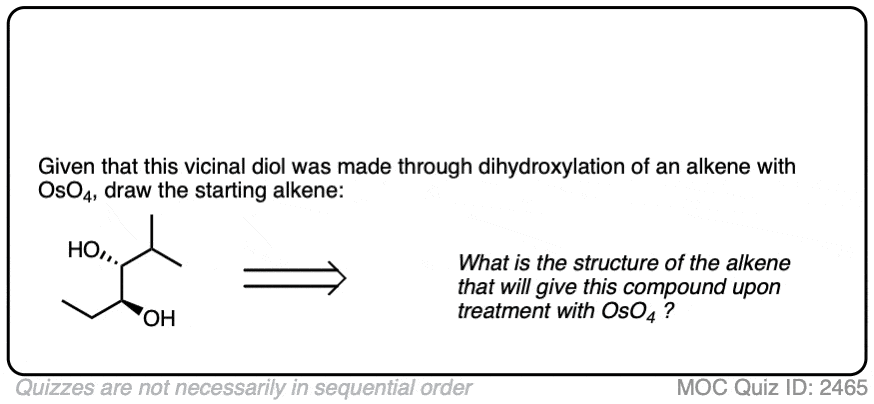 Click to Flip
Click to Flip
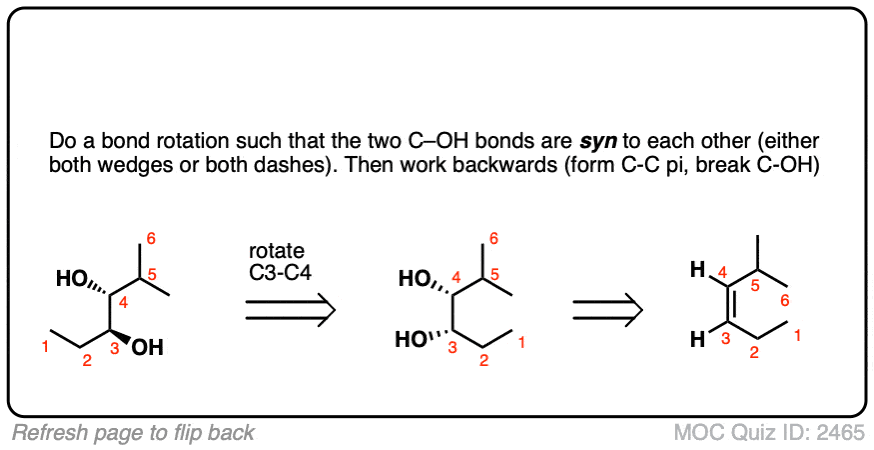
4. OsO4 versus KMnO4 As A Reagent for Dihydroxylation
A reagent similar to OsO4 that is also capable of performing dihydroxylation is potassium permanganate, KMnO4.
Treatment of alkenes with cold, alkaline KMnO4 will also result in vicinal diols.

Like the reaction with OsO4, this also proceeds through a cyclic, concerted transition state that results in a cyclic metal species (this time called a “manganate ester”).
The key difference here is that unless the manganate ester will react further to give the products of oxidative cleavage unless hydroxide ion HO(-) is present to hydrolyze the Mn-O bonds and liberate the vicinal diol. This is not generally a problem with OsO4.
This is also why the temperature is kept low for KMnO4 oxidations.
Yields with KMnO4 tend to be lower and KMnO4 is also much less tolerant of sensitive functional groups like alcohols and aldehydes.
Dihydroxylations with KMnO4 are often used with a phase transfer catalyst.
5. Catalytic OsO4 Using Stoichiometric Oxidant
It’s one thing to write a reaction down on a sheet of paper that uses a stoichiometric amount of osmium tetroxide.
It’s another thing entirely to carry it out in the lab.
For one thing, OsO4 is expensive – $332/g last time I checked, slightly cheaper if you buy in bulk. The other thing is that it is a highly toxic liquid with a low vapor pressure that should be treated with extreme care.
Particularly noteworthy is its potential to cause blindness – all that retinol in your cornea is full of juicy double bonds that OsO4 would love to hydroxylate.
The report on the first synthesis of cortisol from 1952 (see Note 3 below) has a reaction that used 68.48 g of OsO4 . That clocks in at, let’s see… $22,768 worth of OsO4 at today’s prices.
Surely there must be a better way? Thankfully, yes.
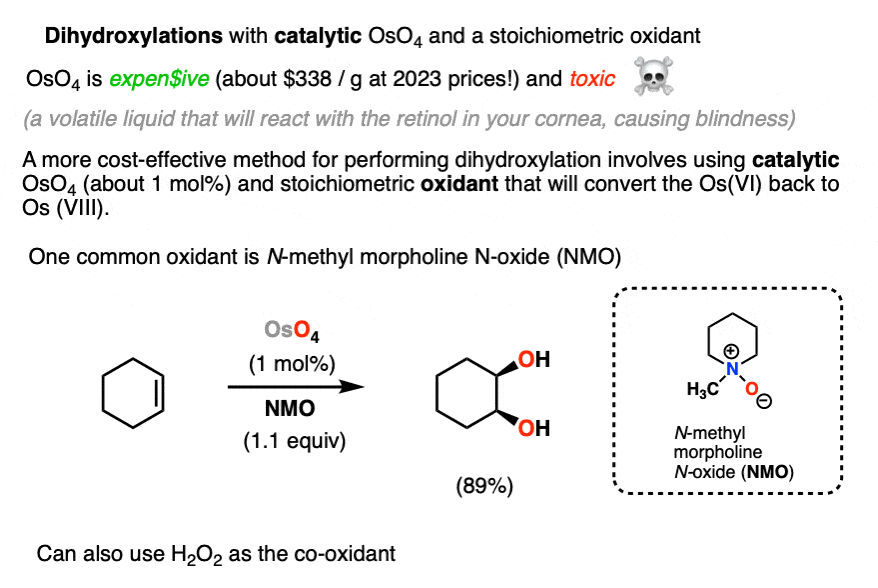
The Upjohn process uses a catalytic amount of OsO4 (usually about 1-2 mol% ) in the presence of a stoichiometric amount of oxidant that converts the Os(VI) product back to OsO4. The oxidant of choice is generally N-methylmorpholine N-oxide (NMO) although various other oxidants can be used.
[The original paper is here – Org Synth. 1978, 58, 43 – and has helpful tables that compare oxidants and also its performance to KMnO4]
Yields are generally high and the reaction is mild. Furthermore there’s no need to add KHSO3 since the osmate ester is cleaved under these conditions.
It’s even possible to perform a hydroxylation on an alkene without affecting an alkyne, as OsO4 does not react with alkynes.

An enantioselective version of dihydroxylation known as the Sharpless asymmetric dihydroxylation has been developed. It also uses catalytic osmium (potassium osmate) in the presence of a stoichiometric amount of oxidant. For more details see [Note 4].
6. Reactions of Vicinal Diols – Cleavage with NaIO4
vicinal diols can undergo oxidative cleavage with various reagents to break a C-C bond and form two new C-O (pi) bonds.
The most commonly used reagents for these purposes are sodium periodate (NaIO4) and lead tetraacetate Pb(OAc)4, although earlier we also touched on the fact that this is a prominent side reaction when performing dihydroxylations with KMnO4.
Sequentially treating a double bond with OsO4 to give a diol followed by oxidative cleavage with NaIO4 or Pb(OAc)4 gives the functional equivalent of ozonolysis (reductive workup).
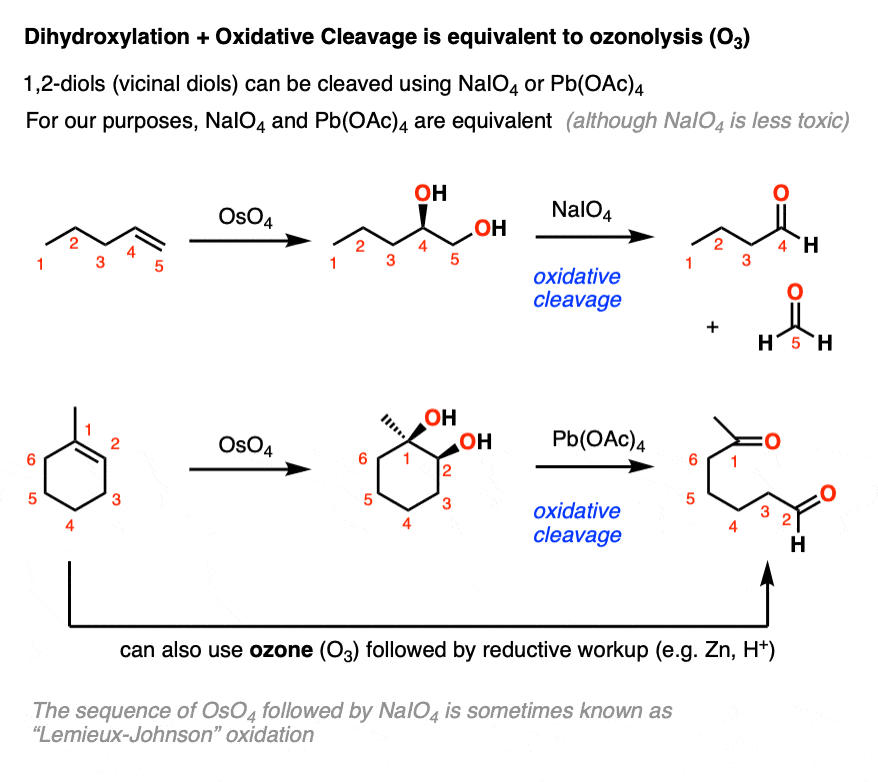
(Later in Org 2, you will learn that diols will react with aldehydes and ketones to form acetals – See article: Hydrates, Hemiacetals, and Acetals)
7. Summary
Let’s summarize the key points we’ve covered about OsO4.
- OsO4 will convert alkenes into vicinal diols (1,2-diols) via a concerted syn addition
- A reducing agent such as KHSO3 is often added to liberate the diol from the osmate ester.
- The diols can undergo oxidative cleavage using a reagent such as NaIO4 or Pb(OAc)4 to give aldehydes/ketones.
- Using the oxidant N-methylmorpholine N-oxide (NMO) allows for the catalytic use of osmium.
- In the presence of multiple alkenes, OsO4 will react with the most electron-rich alkene.
- A related reagent is cold, basic KMnO4 that will also make vicinal syn diols. With KMnO4, however, there is an increased risk of the resulting diol undergoing oxidative cleavage.
Notes
Related Articles
- Reagent Friday: Lindlar’s Catalyst
- Partial Reduction of Alkynes With Lindlar’s Catalyst or Na/NH3 To Obtain Cis or Trans Alkenes
- Types of Isomers: Constitutional Isomers, Stereoisomers, Enantiomers, and Diastereomers
- Enantiomers vs Diastereomers vs The Same? Two Methods For Solving Problems
- Hydrates, Hemiacetals, and Acetals
- Dihydroxylation of Alkenes to give 1,2-diols (MOC Membership) (vicinal diols)
- Alkene Reactions Practice Problems
- Palladium on Carbon (Pd/C) for Catalytic Hydrogenation
- Cyclopropanation of Alkenes
- Stereoselective and Stereospecific Reactions
- Alkene Addition Reactions: “Regioselectivity” and “Stereoselectivity” (Syn/Anti)
Note 1. OsO4 is prepared through burning metallic osmium in an atmosphere of pure oxygen. From Brauer’s Handbook of Preparative Inorganic Chemistry (Academic Press, 1963, New York). (page 1603)
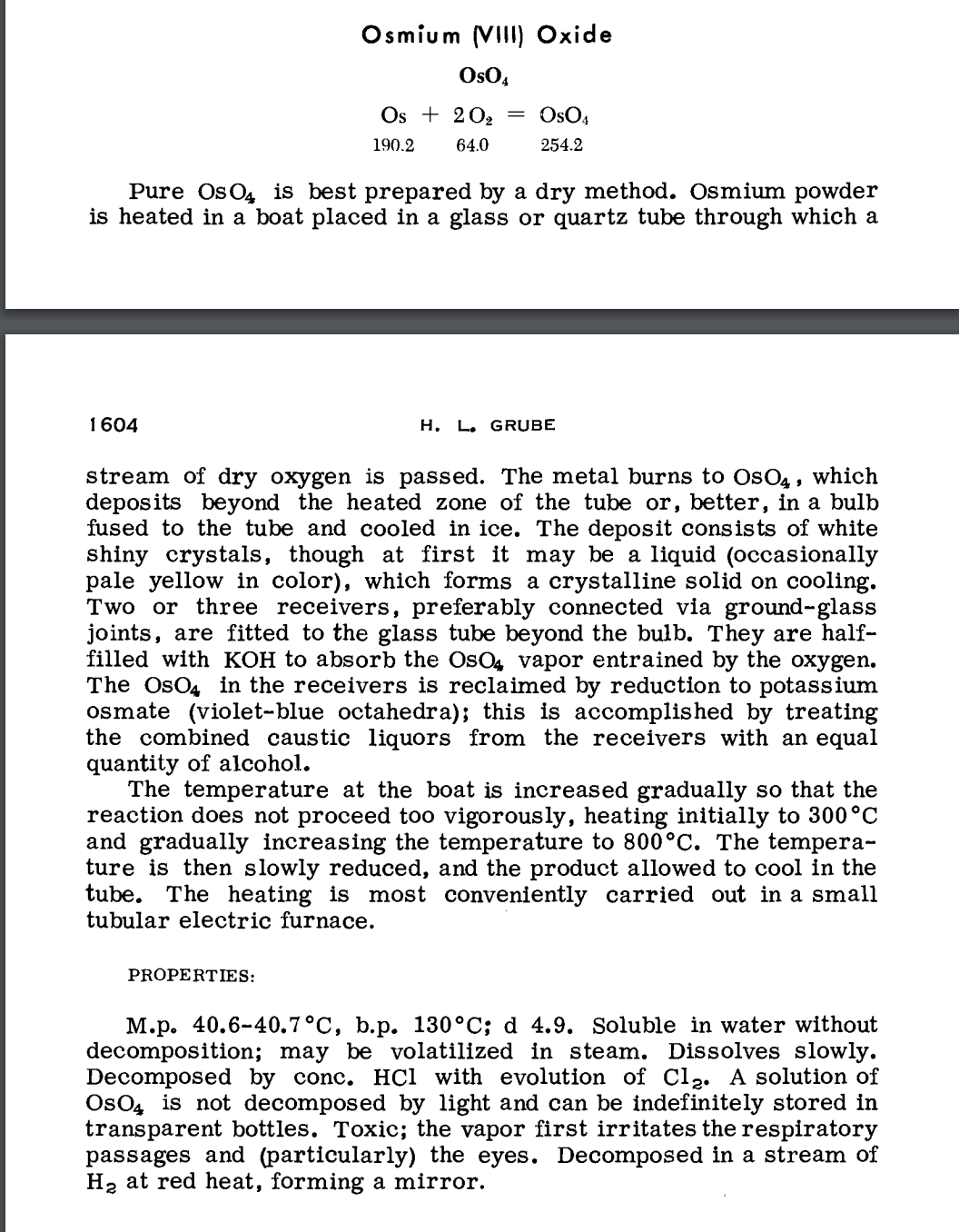
“Pure OsO4 is best prepared by a dry method. Osmium powder is heated in a boat placed in a glass or quartz tube through which a stream of dry oxygen is passed. The metal burns to OsO4, which deposits beyond the heated zone of the tube or, better, in a bulb fused to the tube and cooled in ice. The deposit consists of white shiny crystals, though at first it may be a liquid (occasionally pale yellow in color), which forms a crystalline solid on cooling.”
Note 2. Many crystal structures of osmate esters are known. Here is an example of an osmium ester with adenosine. [Ref – J. Am. Chem. Soc. 1974, 96, 7152]
Note 3. What if a molecule contains multiple alkenes? Which alkene will OsO4 react with?
OsO4 will react with the most electron-rich alkene (i.e. generally the one attached to the most carbon substituents).
For example in this classic synthesis of cortisone from 1952, note that OsO4 preferentially attacks the isolated alkene and doesn’t touch the electron-poor diene that is conjugated to the C=O.
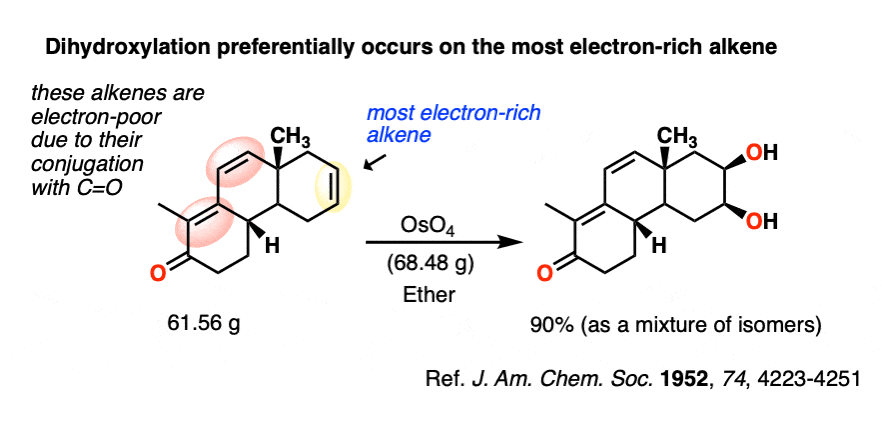
Woodward and his team employed 68.5 g of OsO4 on 61.5 g of substrate. At current market prices this one reaction would cost [checks Aldrich] $23,105 in today’s dollars. Thankfully, using so much OsO4 has been made completely unnecessary by using the co-oxidant N-methylmorpholine N-oxide (NMO).
OsO4 can be made to be even more reactive and even react with very electron-poor alkenes through adding pyridine, which coordinates to osmium and renders it more electron-rich. [Ref]
Note 4. The dihydroxylation reaction has been made even more useful through the work of Prof. K. Barry Sharpless’ research group at Scripps. Using chiral amines to coordinate to osmium and a stoichiometric oxidant, Prof. K. Barry Sharpless’ group at Scripps successfully developed a useful catalytic enantioselective dihydroxylation reaction.
The Sharpless asymmetric dihydroxylation (Sharpless AD) is effective for a wide range of alkenes. For convenience, the oxidant, osmium salt, and chiral ligand are all sold as kits known as “AD-mix α” and “AD-mix β”. Using the mnemonic below, one can choose which of the two reagent kits to use in order to get the desired chiral diol.
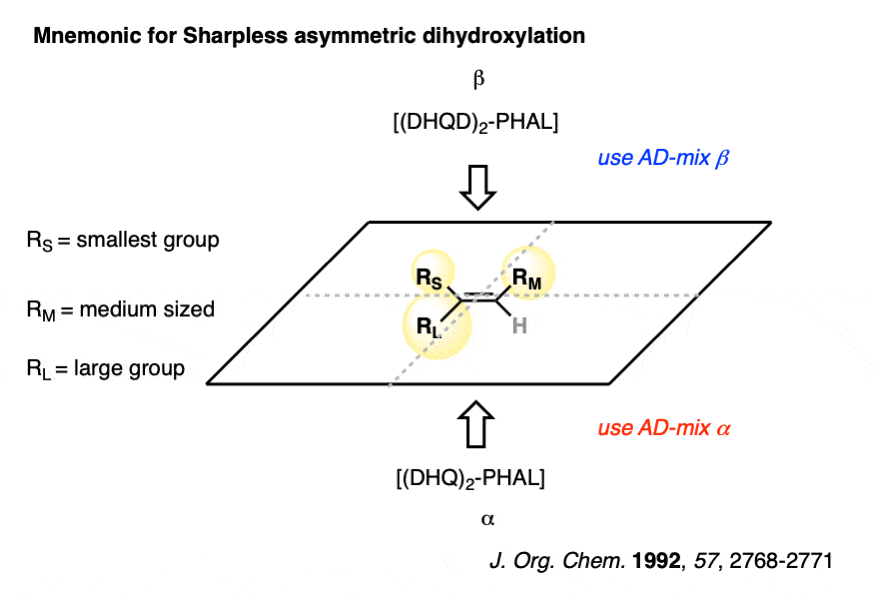
For far more detail see this handout from Prof. Andrew Myers’ Chem 115 course at Harvard or consult Sharpless’ Nobel lecture.
Quiz Yourself!
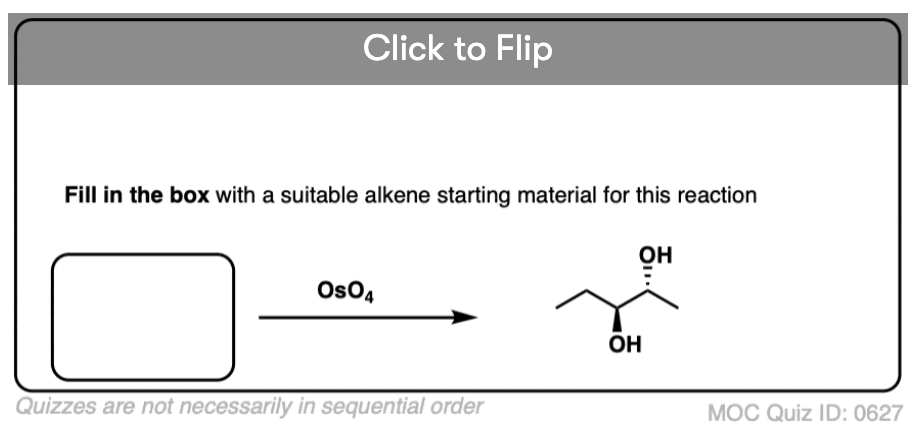
Become a MOC member to see the clickable quiz with answers on the back.
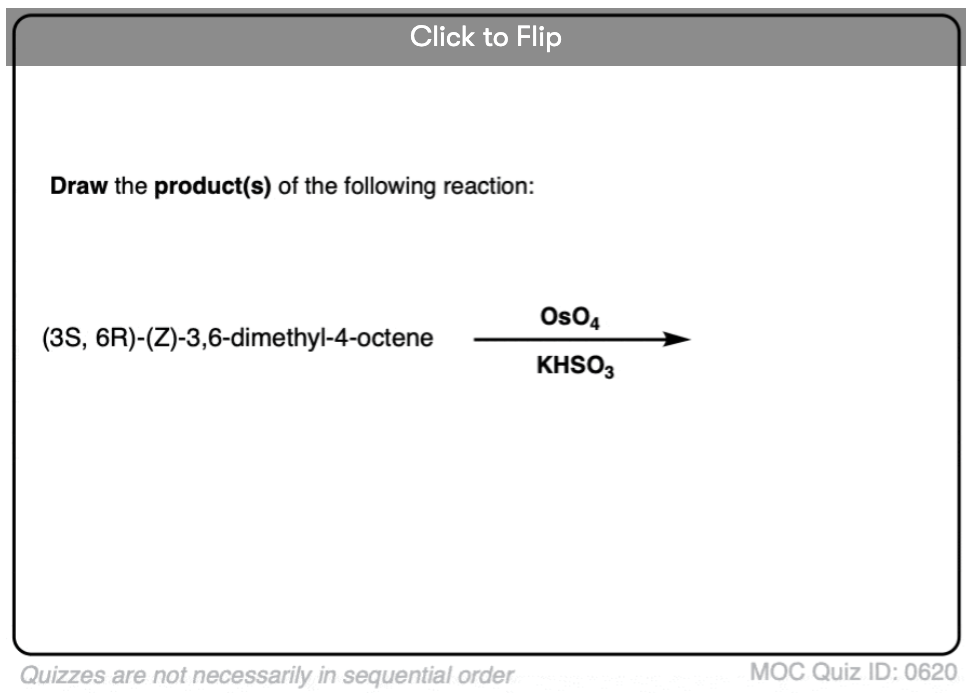
Become a MOC member to see the clickable quiz with answers on the back.

Become a MOC member to see the clickable quiz with answers on the back.

Become a MOC member to see the clickable quiz with answers on the back.
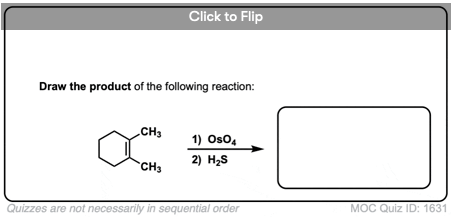
Become a MOC member to see the clickable quiz with answers on the back.
(Advanced) References and Further Reading
For examples of reactions employing OsO4, see:
- Osmium Tetroxide, OsO4. Encyclopedia of Reagents for Organic Syntheses, vol. 6 (N-Sin). Leo Paquette, ed. Wiley.
- Carey & Sundberg. Advanced Organic Chemistry. B: Reactions & Synthesis. Chapter 12, Oxidations. 4th Ed. Kluwer.
- For examples of the Sharpless asymmetric dihydroxylation and leading references, see the handouts by Prof. Andrew G. Myers for Chemistry 115, Harvard University. Link.
- On Two Metals, Found In The Black Powder Remaining After The Solution of Patina
Smithson Tennant
Philosophical Transactions of the Royal Society, 1804, 411
LINK: (JStor)
The first description of what was to become known as OsO4 was made in 1804, where Smithson Tennant observed that the oxide of osmium “stains the skin of a dark color, which cannot be effaced”. In this remarkable paper he also gives names to what came to be called iridium and osmium. -
Zur Kenntnis des Osmiums
Makowka, O.
Chem. Ber. 1908, 41, 943
DOI: 10.1002/cber.190804101182
Believed to be the first application of OsO4 for dihydroxylation of alkenes, from 1908. - Osmium and Its Compounds
W. P. Griffith
Q. Rev. Chem. Soc., 1965,19, 254-273
DOI: 10.1039/QR9651900254
Overview of osmium and some of its reactions. A similar review (from the Johnson-Mathey site) is found here. -
CATALYTIC OSMIUM TETROXIDE OXIDATION OF OLEFINS: cis-1,2-CYCLOHEXANEDIOLV. VanRheenen, D. Y. Cha, and W. M. Hartley
Org. Synth. 1978, 58, 43
DOI: orgsyn.058.0043
The “Upjohn method” for dihydroxylation of alkenes using catalytic OsO4 and stoichiometric NMO (N-methyl morpholine N-oxide) in Organic Syntheses. - The Total Synthesis of Steroids
R. B. Woodward, Franz Sondheimer, David Taub, Karl Heusler, and W. M. McLamoreJournal of the American Chemical Society 1952 74 (17), 4223-4251
DOI: 10.1021/ja01137a001
One step of this paper involves hydroxylation of 61.5 g of substrate with 68.5 g of OsO4. - Nobel Lecture
K. Barry Sharpless
LINK
Prof. Barry Sharpless won the 2001 Nobel Prize in chemistry for the development of asymmetric catalysis. His 2001 Nobel Lecture describes the path toward making asymmetric dihydoxylation a useful process (starts on page 11). - Osmium tetraoxide cis hydroxylation of unsaturated substrates
Martin Schroeder
Chemical Reviews 1980 80 (2), 187-213
DOI: 10.1021/cr60324a003
Comprehensive review on the dihydroxylation of alkenes with OsO4 up to 1980. -
Experimental and Theoretical Kinetic Isotope Effects for Asymmetric Dihydroxylation. Evidence Supporting a Rate-Limiting “(3 + 2)” Cycloaddition
Albert J. DelMonte, Jan Haller, K. N. Houk, K. Barry Sharpless, Daniel A. Singleton, Thomas Strassner, and Allen A. Thomas
Journal of the American Chemical Society 1997 119 (41), 9907-9908
DOI: 10.1021/ja971650e
Study on the mechanism of the dihydroxylation of alkenes that supports a [3+2] versus a [2+2] mechanism.
00 General Chemistry Review
01 Bonding, Structure, and Resonance
- How Do We Know Methane (CH4) Is Tetrahedral?
- Hybrid Orbitals and Hybridization
- How To Determine Hybridization: A Shortcut
- Orbital Hybridization And Bond Strengths
- Sigma bonds come in six varieties: Pi bonds come in one
- A Key Skill: How to Calculate Formal Charge
- The Four Intermolecular Forces and How They Affect Boiling Points
- 3 Trends That Affect Boiling Points
- How To Use Electronegativity To Determine Electron Density (and why NOT to trust formal charge)
- Introduction to Resonance
- How To Use Curved Arrows To Interchange Resonance Forms
- Evaluating Resonance Forms (1) - The Rule of Least Charges
- How To Find The Best Resonance Structure By Applying Electronegativity
- Evaluating Resonance Structures With Negative Charges
- Evaluating Resonance Structures With Positive Charge
- Exploring Resonance: Pi-Donation
- Exploring Resonance: Pi-acceptors
- In Summary: Evaluating Resonance Structures
- Drawing Resonance Structures: 3 Common Mistakes To Avoid
- How to apply electronegativity and resonance to understand reactivity
- Bond Hybridization Practice
- Structure and Bonding Practice Quizzes
- Resonance Structures Practice
02 Acid Base Reactions
- Introduction to Acid-Base Reactions
- Acid Base Reactions In Organic Chemistry
- The Stronger The Acid, The Weaker The Conjugate Base
- Walkthrough of Acid-Base Reactions (3) - Acidity Trends
- Five Key Factors That Influence Acidity
- Acid-Base Reactions: Introducing Ka and pKa
- How to Use a pKa Table
- The pKa Table Is Your Friend
- A Handy Rule of Thumb for Acid-Base Reactions
- Acid Base Reactions Are Fast
- pKa Values Span 60 Orders Of Magnitude
- How Protonation and Deprotonation Affect Reactivity
- Acid Base Practice Problems
03 Alkanes and Nomenclature
- Meet the (Most Important) Functional Groups
- Condensed Formulas: Deciphering What the Brackets Mean
- Hidden Hydrogens, Hidden Lone Pairs, Hidden Counterions
- Don't Be Futyl, Learn The Butyls
- Primary, Secondary, Tertiary, Quaternary In Organic Chemistry
- Branching, and Its Affect On Melting and Boiling Points
- The Many, Many Ways of Drawing Butane
- Wedge And Dash Convention For Tetrahedral Carbon
- Common Mistakes in Organic Chemistry: Pentavalent Carbon
- Table of Functional Group Priorities for Nomenclature
- Summary Sheet - Alkane Nomenclature
- Organic Chemistry IUPAC Nomenclature Demystified With A Simple Puzzle Piece Approach
- Boiling Point Quizzes
- Organic Chemistry Nomenclature Quizzes
04 Conformations and Cycloalkanes
- Staggered vs Eclipsed Conformations of Ethane
- Conformational Isomers of Propane
- Newman Projection of Butane (and Gauche Conformation)
- Introduction to Cycloalkanes
- Geometric Isomers In Small Rings: Cis And Trans Cycloalkanes
- Calculation of Ring Strain In Cycloalkanes
- Cycloalkanes - Ring Strain In Cyclopropane And Cyclobutane
- Cyclohexane Conformations
- Cyclohexane Chair Conformation: An Aerial Tour
- How To Draw The Cyclohexane Chair Conformation
- The Cyclohexane Chair Flip
- The Cyclohexane Chair Flip - Energy Diagram
- Substituted Cyclohexanes - Axial vs Equatorial
- Ranking The Bulkiness Of Substituents On Cyclohexanes: "A-Values"
- Cyclohexane Chair Conformation Stability: Which One Is Lower Energy?
- Fused Rings - Cis-Decalin and Trans-Decalin
- Naming Bicyclic Compounds - Fused, Bridged, and Spiro
- Bredt's Rule (And Summary of Cycloalkanes)
- Newman Projection Practice
- Cycloalkanes Practice Problems
05 A Primer On Organic Reactions
- The Most Important Question To Ask When Learning a New Reaction
- Curved Arrows (for reactions)
- Nucleophiles and Electrophiles
- The Three Classes of Nucleophiles
- Nucleophilicity vs. Basicity
- What Makes A Good Nucleophile?
- What Makes A Good Leaving Group?
- 3 Factors That Stabilize Carbocations
- Equilibrium and Energy Relationships
- 7 Factors that stabilize negative charge in organic chemistry
- 7 Factors That Stabilize Positive Charge in Organic Chemistry
- What's a Transition State?
- Hammond's Postulate
- Learning Organic Chemistry Reactions: A Checklist (PDF)
- Introduction to Oxidative Cleavage Reactions
06 Free Radical Reactions
- Bond Dissociation Energies = Homolytic Cleavage
- Free Radical Reactions
- 3 Factors That Stabilize Free Radicals
- What Factors Destabilize Free Radicals?
- Bond Strengths And Radical Stability
- Free Radical Initiation: Why Is "Light" Or "Heat" Required?
- Initiation, Propagation, Termination
- Monochlorination Products Of Propane, Pentane, And Other Alkanes
- Selectivity In Free Radical Reactions
- Selectivity in Free Radical Reactions: Bromination vs. Chlorination
- Halogenation At Tiffany's
- Allylic Bromination
- Bonus Topic: Allylic Rearrangements
- In Summary: Free Radicals
- Synthesis (2) - Reactions of Alkanes
- Free Radicals Practice Quizzes
07 Stereochemistry and Chirality
- Types of Isomers: Constitutional Isomers, Stereoisomers, Enantiomers, and Diastereomers
- How To Draw The Enantiomer Of A Chiral Molecule
- How To Draw A Bond Rotation
- Introduction to Assigning (R) and (S): The Cahn-Ingold-Prelog Rules
- Assigning Cahn-Ingold-Prelog (CIP) Priorities (2) - The Method of Dots
- Enantiomers vs Diastereomers vs The Same? Two Methods For Solving Problems
- Assigning R/S To Newman Projections (And Converting Newman To Line Diagrams)
- How To Determine R and S Configurations On A Fischer Projection
- The Meso Trap
- Optical Rotation, Optical Activity, and Specific Rotation
- Optical Purity and Enantiomeric Excess
- What's a Racemic Mixture?
- Chiral Allenes And Chiral Axes
- Stereochemistry Practice Problems and Quizzes
08 Substitution Reactions
- Nucleophilic Substitution Reactions - Introduction
- Two Types of Nucleophilic Substitution Reactions
- The SN2 Mechanism
- Why the SN2 Reaction Is Powerful
- The SN1 Mechanism
- The Conjugate Acid Is A Better Leaving Group
- Comparing the SN1 and SN2 Reactions
- Polar Protic? Polar Aprotic? Nonpolar? All About Solvents
- Steric Hindrance is Like a Fat Goalie
- Common Blind Spot: Intramolecular Reactions
- Substitution Practice - SN1
- Substitution Practice - SN2
09 Elimination Reactions
- Elimination Reactions (1): Introduction And The Key Pattern
- Elimination Reactions (2): The Zaitsev Rule
- Elimination Reactions Are Favored By Heat
- Two Elimination Reaction Patterns
- The E1 Reaction
- The E2 Mechanism
- E1 vs E2: Comparing the E1 and E2 Reactions
- Antiperiplanar Relationships: The E2 Reaction and Cyclohexane Rings
- Bulky Bases in Elimination Reactions
- Comparing the E1 vs SN1 Reactions
- Elimination (E1) Reactions With Rearrangements
- E1cB - Elimination (Unimolecular) Conjugate Base
- Elimination (E1) Practice Problems And Solutions
- Elimination (E2) Practice Problems and Solutions
10 Rearrangements
11 SN1/SN2/E1/E2 Decision
- Identifying Where Substitution and Elimination Reactions Happen
- Deciding SN1/SN2/E1/E2 (1) - The Substrate
- Deciding SN1/SN2/E1/E2 (2) - The Nucleophile/Base
- SN1 vs E1 and SN2 vs E2 : The Temperature
- Deciding SN1/SN2/E1/E2 - The Solvent
- Wrapup: The Key Factors For Determining SN1/SN2/E1/E2
- Alkyl Halide Reaction Map And Summary
- SN1 SN2 E1 E2 Practice Problems
12 Alkene Reactions
- E and Z Notation For Alkenes (+ Cis/Trans)
- Alkene Stability
- Alkene Addition Reactions: "Regioselectivity" and "Stereoselectivity" (Syn/Anti)
- Stereoselective and Stereospecific Reactions
- Hydrohalogenation of Alkenes and Markovnikov's Rule
- Hydration of Alkenes With Aqueous Acid
- Rearrangements in Alkene Addition Reactions
- Halogenation of Alkenes and Halohydrin Formation
- Oxymercuration Demercuration of Alkenes
- Hydroboration Oxidation of Alkenes
- m-CPBA (meta-chloroperoxybenzoic acid)
- OsO4 (Osmium Tetroxide) for Dihydroxylation of Alkenes
- Palladium on Carbon (Pd/C) for Catalytic Hydrogenation of Alkenes
- Cyclopropanation of Alkenes
- A Fourth Alkene Addition Pattern - Free Radical Addition
- Alkene Reactions: Ozonolysis
- Summary: Three Key Families Of Alkene Reaction Mechanisms
- Synthesis (4) - Alkene Reaction Map, Including Alkyl Halide Reactions
- Alkene Reactions Practice Problems
13 Alkyne Reactions
- Acetylides from Alkynes, And Substitution Reactions of Acetylides
- Partial Reduction of Alkynes With Lindlar's Catalyst
- Partial Reduction of Alkynes With Na/NH3 To Obtain Trans Alkenes
- Alkyne Hydroboration With "R2BH"
- Hydration and Oxymercuration of Alkynes
- Hydrohalogenation of Alkynes
- Alkyne Halogenation: Bromination, Chlorination, and Iodination of Alkynes
- Alkyne Reactions - The "Concerted" Pathway
- Alkenes To Alkynes Via Halogenation And Elimination Reactions
- Alkynes Are A Blank Canvas
- Synthesis (5) - Reactions of Alkynes
- Alkyne Reactions Practice Problems With Answers
14 Alcohols, Epoxides and Ethers
- Alcohols - Nomenclature and Properties
- Alcohols Can Act As Acids Or Bases (And Why It Matters)
- Alcohols - Acidity and Basicity
- The Williamson Ether Synthesis
- Ethers From Alkenes, Tertiary Alkyl Halides and Alkoxymercuration
- Alcohols To Ethers via Acid Catalysis
- Cleavage Of Ethers With Acid
- Epoxides - The Outlier Of The Ether Family
- Opening of Epoxides With Acid
- Epoxide Ring Opening With Base
- Making Alkyl Halides From Alcohols
- Tosylates And Mesylates
- PBr3 and SOCl2
- Elimination Reactions of Alcohols
- Elimination of Alcohols To Alkenes With POCl3
- Alcohol Oxidation: "Strong" and "Weak" Oxidants
- Demystifying The Mechanisms of Alcohol Oxidations
- Protecting Groups For Alcohols
- Thiols And Thioethers
- Calculating the oxidation state of a carbon
- Oxidation and Reduction in Organic Chemistry
- Oxidation Ladders
- SOCl2 Mechanism For Alcohols To Alkyl Halides: SN2 versus SNi
- Alcohol Reactions Roadmap (PDF)
- Alcohol Reaction Practice Problems
- Epoxide Reaction Quizzes
- Oxidation and Reduction Practice Quizzes
15 Organometallics
- What's An Organometallic?
- Formation of Grignard and Organolithium Reagents
- Organometallics Are Strong Bases
- Reactions of Grignard Reagents
- Protecting Groups In Grignard Reactions
- Synthesis Problems Involving Grignard Reagents
- Grignard Reactions And Synthesis (2)
- Organocuprates (Gilman Reagents): How They're Made
- Gilman Reagents (Organocuprates): What They're Used For
- The Heck, Suzuki, and Olefin Metathesis Reactions (And Why They Don't Belong In Most Introductory Organic Chemistry Courses)
- Reaction Map: Reactions of Organometallics
- Grignard Practice Problems
16 Spectroscopy
- Degrees of Unsaturation (or IHD, Index of Hydrogen Deficiency)
- Conjugation And Color (+ How Bleach Works)
- Introduction To UV-Vis Spectroscopy
- UV-Vis Spectroscopy: Absorbance of Carbonyls
- UV-Vis Spectroscopy: Practice Questions
- Bond Vibrations, Infrared Spectroscopy, and the "Ball and Spring" Model
- Infrared Spectroscopy: A Quick Primer On Interpreting Spectra
- IR Spectroscopy: 4 Practice Problems
- 1H NMR: How Many Signals?
- Homotopic, Enantiotopic, Diastereotopic
- Diastereotopic Protons in 1H NMR Spectroscopy: Examples
- 13-C NMR - How Many Signals
- Liquid Gold: Pheromones In Doe Urine
- Natural Product Isolation (1) - Extraction
- Natural Product Isolation (2) - Purification Techniques, An Overview
- Structure Determination Case Study: Deer Tarsal Gland Pheromone
17 Dienes and MO Theory
- What To Expect In Organic Chemistry 2
- Are these molecules conjugated?
- Conjugation And Resonance In Organic Chemistry
- Bonding And Antibonding Pi Orbitals
- Molecular Orbitals of The Allyl Cation, Allyl Radical, and Allyl Anion
- Pi Molecular Orbitals of Butadiene
- Reactions of Dienes: 1,2 and 1,4 Addition
- Thermodynamic and Kinetic Products
- More On 1,2 and 1,4 Additions To Dienes
- s-cis and s-trans
- The Diels-Alder Reaction
- Cyclic Dienes and Dienophiles in the Diels-Alder Reaction
- Stereochemistry of the Diels-Alder Reaction
- Exo vs Endo Products In The Diels Alder: How To Tell Them Apart
- HOMO and LUMO In the Diels Alder Reaction
- Why Are Endo vs Exo Products Favored in the Diels-Alder Reaction?
- Diels-Alder Reaction: Kinetic and Thermodynamic Control
- The Retro Diels-Alder Reaction
- The Intramolecular Diels Alder Reaction
- Regiochemistry In The Diels-Alder Reaction
- The Cope and Claisen Rearrangements
- Electrocyclic Reactions
- Electrocyclic Ring Opening And Closure (2) - Six (or Eight) Pi Electrons
- Diels Alder Practice Problems
- Molecular Orbital Theory Practice
18 Aromaticity
- Introduction To Aromaticity
- Rules For Aromaticity
- Huckel's Rule: What Does 4n+2 Mean?
- Aromatic, Non-Aromatic, or Antiaromatic? Some Practice Problems
- Antiaromatic Compounds and Antiaromaticity
- The Pi Molecular Orbitals of Benzene
- The Pi Molecular Orbitals of Cyclobutadiene
- Frost Circles
- Aromaticity Practice Quizzes
19 Reactions of Aromatic Molecules
- Electrophilic Aromatic Substitution: Introduction
- Activating and Deactivating Groups In Electrophilic Aromatic Substitution
- Electrophilic Aromatic Substitution - The Mechanism
- Ortho-, Para- and Meta- Directors in Electrophilic Aromatic Substitution
- Understanding Ortho, Para, and Meta Directors
- Why are halogens ortho- para- directors?
- Disubstituted Benzenes: The Strongest Electron-Donor "Wins"
- Electrophilic Aromatic Substitutions (1) - Halogenation of Benzene
- Electrophilic Aromatic Substitutions (2) - Nitration and Sulfonation
- EAS Reactions (3) - Friedel-Crafts Acylation and Friedel-Crafts Alkylation
- Intramolecular Friedel-Crafts Reactions
- Nucleophilic Aromatic Substitution (NAS)
- Nucleophilic Aromatic Substitution (2) - The Benzyne Mechanism
- Reactions on the "Benzylic" Carbon: Bromination And Oxidation
- The Wolff-Kishner, Clemmensen, And Other Carbonyl Reductions
- More Reactions on the Aromatic Sidechain: Reduction of Nitro Groups and the Baeyer Villiger
- Aromatic Synthesis (1) - "Order Of Operations"
- Synthesis of Benzene Derivatives (2) - Polarity Reversal
- Aromatic Synthesis (3) - Sulfonyl Blocking Groups
- Birch Reduction
- Synthesis (7): Reaction Map of Benzene and Related Aromatic Compounds
- Aromatic Reactions and Synthesis Practice
- Electrophilic Aromatic Substitution Practice Problems
20 Aldehydes and Ketones
- What's The Alpha Carbon In Carbonyl Compounds?
- Nucleophilic Addition To Carbonyls
- Aldehydes and Ketones: 14 Reactions With The Same Mechanism
- Sodium Borohydride (NaBH4) Reduction of Aldehydes and Ketones
- Grignard Reagents For Addition To Aldehydes and Ketones
- Wittig Reaction
- Hydrates, Hemiacetals, and Acetals
- Imines - Properties, Formation, Reactions, and Mechanisms
- All About Enamines
- Breaking Down Carbonyl Reaction Mechanisms: Reactions of Anionic Nucleophiles (Part 2)
- Aldehydes Ketones Reaction Practice
21 Carboxylic Acid Derivatives
- Nucleophilic Acyl Substitution (With Negatively Charged Nucleophiles)
- Addition-Elimination Mechanisms With Neutral Nucleophiles (Including Acid Catalysis)
- Basic Hydrolysis of Esters - Saponification
- Transesterification
- Proton Transfer
- Fischer Esterification - Carboxylic Acid to Ester Under Acidic Conditions
- Lithium Aluminum Hydride (LiAlH4) For Reduction of Carboxylic Acid Derivatives
- LiAlH[Ot-Bu]3 For The Reduction of Acid Halides To Aldehydes
- Di-isobutyl Aluminum Hydride (DIBAL) For The Partial Reduction of Esters and Nitriles
- Amide Hydrolysis
- Thionyl Chloride (SOCl2) And Conversion of Carboxylic Acids to Acid Halides
- Diazomethane (CH2N2)
- Carbonyl Chemistry: Learn Six Mechanisms For the Price Of One
- Making Music With Mechanisms (PADPED)
- Carboxylic Acid Derivatives Practice Questions
22 Enols and Enolates
- Keto-Enol Tautomerism
- Enolates - Formation, Stability, and Simple Reactions
- Kinetic Versus Thermodynamic Enolates
- Aldol Addition and Condensation Reactions
- Reactions of Enols - Acid-Catalyzed Aldol, Halogenation, and Mannich Reactions
- Claisen Condensation and Dieckmann Condensation
- Decarboxylation
- The Malonic Ester and Acetoacetic Ester Synthesis
- The Michael Addition Reaction and Conjugate Addition
- The Robinson Annulation
- Haloform Reaction
- The Hell–Volhard–Zelinsky Reaction
- Enols and Enolates Practice Quizzes
23 Amines
- The Amide Functional Group: Properties, Synthesis, and Nomenclature
- Basicity of Amines And pKaH
- 5 Key Basicity Trends of Amines
- The Mesomeric Effect And Aromatic Amines
- Nucleophilicity of Amines
- Alkylation of Amines (Sucks!)
- Reductive Amination
- The Gabriel Synthesis
- Some Reactions of Azides
- The Hofmann Elimination
- The Hofmann and Curtius Rearrangements
- The Cope Elimination
- Protecting Groups for Amines - Carbamates
- The Strecker Synthesis of Amino Acids
- Introduction to Peptide Synthesis
- Reactions of Diazonium Salts: Sandmeyer and Related Reactions
- Amine Practice Questions
24 Carbohydrates
- D and L Notation For Sugars
- Pyranoses and Furanoses: Ring-Chain Tautomerism In Sugars
- What is Mutarotation?
- Reducing Sugars
- The Big Damn Post Of Carbohydrate-Related Chemistry Definitions
- The Haworth Projection
- Converting a Fischer Projection To A Haworth (And Vice Versa)
- Reactions of Sugars: Glycosylation and Protection
- The Ruff Degradation and Kiliani-Fischer Synthesis
- Isoelectric Points of Amino Acids (and How To Calculate Them)
- Carbohydrates Practice
- Amino Acid Quizzes
25 Fun and Miscellaneous
- A Gallery of Some Interesting Molecules From Nature
- Screw Organic Chemistry, I'm Just Going To Write About Cats
- On Cats, Part 1: Conformations and Configurations
- On Cats, Part 2: Cat Line Diagrams
- On Cats, Part 4: Enantiocats
- On Cats, Part 6: Stereocenters
- Organic Chemistry Is Shit
- The Organic Chemistry Behind "The Pill"
- Maybe they should call them, "Formal Wins" ?
- Why Do Organic Chemists Use Kilocalories?
- The Principle of Least Effort
- Organic Chemistry GIFS - Resonance Forms
- Reproducibility In Organic Chemistry
- What Holds The Nucleus Together?
- How Reactions Are Like Music
- Organic Chemistry and the New MCAT
26 Organic Chemistry Tips and Tricks
- Common Mistakes: Formal Charges Can Mislead
- Partial Charges Give Clues About Electron Flow
- Draw The Ugly Version First
- Organic Chemistry Study Tips: Learn the Trends
- The 8 Types of Arrows In Organic Chemistry, Explained
- Top 10 Skills To Master Before An Organic Chemistry 2 Final
- Common Mistakes with Carbonyls: Carboxylic Acids... Are Acids!
- Planning Organic Synthesis With "Reaction Maps"
- Alkene Addition Pattern #1: The "Carbocation Pathway"
- Alkene Addition Pattern #2: The "Three-Membered Ring" Pathway
- Alkene Addition Pattern #3: The "Concerted" Pathway
- Number Your Carbons!
- The 4 Major Classes of Reactions in Org 1
- How (and why) electrons flow
- Grossman's Rule
- Three Exam Tips
- A 3-Step Method For Thinking Through Synthesis Problems
- Putting It Together
- Putting Diels-Alder Products in Perspective
- The Ups and Downs of Cyclohexanes
- The Most Annoying Exceptions in Org 1 (Part 1)
- The Most Annoying Exceptions in Org 1 (Part 2)
- The Marriage May Be Bad, But the Divorce Still Costs Money
- 9 Nomenclature Conventions To Know
- Nucleophile attacks Electrophile
27 Case Studies of Successful O-Chem Students
- Success Stories: How Corina Got The The "Hard" Professor - And Got An A+ Anyway
- How Helena Aced Organic Chemistry
- From a "Drop" To B+ in Org 2 – How A Hard Working Student Turned It Around
- How Serge Aced Organic Chemistry
- Success Stories: How Zach Aced Organic Chemistry 1
- Success Stories: How Kari Went From C– to B+
- How Esther Bounced Back From a "C" To Get A's In Organic Chemistry 1 And 2
- How Tyrell Got The Highest Grade In Her Organic Chemistry Course
- This Is Why Students Use Flashcards
- Success Stories: How Stu Aced Organic Chemistry
- How John Pulled Up His Organic Chemistry Exam Grades
- Success Stories: How Nathan Aced Organic Chemistry (Without It Taking Over His Life)
- How Chris Aced Org 1 and Org 2
- Interview: How Jay Got an A+ In Organic Chemistry
- How to Do Well in Organic Chemistry: One Student's Advice
- "America's Top TA" Shares His Secrets For Teaching O-Chem
- "Organic Chemistry Is Like..." - A Few Metaphors
- How To Do Well In Organic Chemistry: Advice From A Tutor
- Guest post: "I went from being afraid of tests to actually looking forward to them".
According to my lecture slides, dihydroxylation of alkenes with cat. OSO4 and NMO requires water as a solvent (in terms of the mechanism, I guess this is for protonation of O in the OsO4 during the reaction?). So would this reaction still proceed if the solvent is changed to CH2Cl2 instead of water?
Hi – you can use nonpolar solvents such as diethyl ether or benzene but you don’t get catalytic turnover. That means you have to use stoichiometric OsO4. The eventual product is an osmate salt that has to be treated with a reductant like bisulfite or H2S to get back the diol. Since osmium is very expensive, this is not advised.
The NMO and water helps with catalytic turnover. There are several important catalytic cycles going on.
1) OsO4 (osmium VIII) performs a dihydroxylation on the alkene, resulting in an osmate ester [Osmium (VI) ]
2) This osmate ester has to be hydrolyzed to give the osmate salt.
3) The osmate (VI) salt is re-oxidized to osmium tetraoxide (Os VIII) with NMO.
[If you want to be picky, coordination of amines like N-methyl morpholine to osmium also helps, increasing the rate of dihydroxylation versus the absence of amines]
Water serves several purposes. The first purpose is to act as a solvent for the highly polar osmate salt and NMO; the second is to act as a nucleophile (under mildly basic conditions, there is likely some HO(-) around) to cleave the osmate ester.
For more commentary, the original paper is here (https://www.sciencedirect.com/science/article/abs/pii/S0040403900780932) – I don’t have full access.
How do you determine the oxidation state of osmium in the osmate ester form? Also, I would think that the lone pair that went onto osmium during the 3+2 cycloaddition has to be accounted for, but I’m not sure how.
Hi – great questions. Start with neutral osmium having an oxidation state of zero. Then subtract 1 for every bond to a more electronegative atom (O). In OsO4 there are eight. In the osmate ester there are six bonds to oxygen. This accounts for the difference in oxidation state – it has gone from Os(VIII) to Os(VI)
What happens when the lone pair goes into Os during the [3+2] is that there are an extra pair of electrons on osmium that weren’t there before. We generally don’t draw the lone pairs in on transition metals (because there can be a lot!). But if we know the oxidation state, we can figure it out. The oxidation state is now two less due to that lone pair.
In your diagrams for dihydroxylation of cis- and trans-pent-2-ene, you have the two products from the cis isomer correctly labelled as 2R,3S and 2S,3R … but for the trans isomer, the enantiomer to the 2R, 3R product is labeled as 2R,3R but it’s really 2S,3S
fixed! thanks for the catch. James
I appreciate you sharing this blog post. Thanks Again. Cool.
Dear Dr
James
I think I found a way how to this, without protecting the aldehyde. I would appreciate to get your opinion
Stage 1: reaction with peroxide to get epoxide
Stage 2: acidificaion
Without knowing the structure, it’s hard to say. Is it an alpha, beta unsaturated aldehyde? Epoxidation may work, but then again peroxide may end up oxidizing your aldehyde.
Aldehydes are some of the most sensitive functional groups to oxidation and other side reactions. I would generally suggest they are protected unless you have some strong reason for believing it would not be affected by the OsO4 or its co-oxidant.
Dear James
If we have a molecule which contain both alkene and aldehide’and we want to prepare diol. will osmium tetraoxide oxidize the aldehide? If yes can you suggest me how to get the diol without oxidizing the akdehide?
Hi Ptachia – I would not do a dihydroxylation with an unprotected aldehyde. Too many things can go wrong. Either keep it at the protected alcohol stage and then oxidize up afterwards, or protect the aldehyde as an acetal and then perform the dihydroxylation.
I do not believe that products in Example 1 are meso compounds that result from the syn addition. They certainly look like the products of anti-addition. Both -OH groups should be either wedged or dashed, if added on the same side. Here they are the same but on different sides. If you rotate, they definitely look like the products from anti-addition (the example on hydroxylation of a linear alkene).
Hi, it doesn’t say that they are meso compounds in this specific example, it says they are a mixture of enantiomers.
However, what about example 2?
James I am looking to recover osmium in a mixture of strong acids at high temperature from a HNO3, H2SO4, HCl digestion. Had no luck complexing it with thiourea since acids + heat = destroyed complexing agent. I’m basically looking to prevent OsO4 formation and recover low level Os spikes. Any help would be greatly appreciated. Regards
I’m sorry but I really don’t know. There has been a lot of work on heavy metal remediation in soils and in solution but I don’t know about how well they stand up to strong acids. E.g. http://www.chem.ccu.edu.tw/~joyce/C%26EN-NEWS/PDF/J.%20Am.%20Chem.%20Soc.%202005,%20127,%2010045-10050.pdf
Hey James,
Reaction of alkenes with cold KMnO4 and OsO4 results in d production of cis -Diol .is there any reaction for production of trans-diol????
Yes, the Woodward-Prevost dihydroxylation. Start by making an iodonium ion, and then there is double displacement by carboxylate to give a 5 membered ring, followed by hydrolysis. https://www.organic-chemistry.org/namedreactions/woodward-reaction.shtm
Why can HIO4 not react with alkenes
Great question. It just doesn’t. Although it will react nicely with diols.
Hi James,
How exactly does the H2O2 hydrolyze the intermediate 5-member ring? Does it donate a proton onto the Oxygen involved in the C-O bond? If so, why would the oxygen want to form that O-H bond instead of remaining with the rest of the ring?
Hey thanks for all your help and dedication to furthering education. Really appreciate your help with making these pages. Between this and the people at Clutchprep I’m acing organic chem and can’t wait for orgo II, bio chem, and pharmacy school next august.
Cheers :)
What is the effect of H2O2 on the action of OSO4?
When the reaction is done, “H2O2” re-oxidizes the OsO2(OH)2 back to OsO4. It’s a reoxidant, which allows OsO4 to be used catalytically. A more common reagent for this purpose is N-methyl morpholine N- oxide (NMO)
Hi, just wondering in what cases does OsO4 fail? Certain alkenes? What about enones (I’ve seen that it does some enones but wondering if some cases would fail)? And how are the reactivities between OsO4 and K2OsO4 differ, besides the latter having hydrates and not useful for moisture sensitive reactions? Thanks!
Well done with Master Organic Chemistry. It is clean, simple, and useful.
Why isn’t the stereoisomer for the cyclo hexene drawn (side question)? I feel like the answer’s at the tip of my tongue but I can’t quite get it.
What’s the definition of an “enantiomer” ? : – )
Since one of those reactions gives a mix of products (enantiomers) while the other gives only one product, the reaction in general is stereoselective?
Whether you get one product or a mixture of enantiomers/diastereomers will depend on the alkene you start with.
Dihydroxylation of ethene would only give one product, for example.
The reaction itself is stereoselective. Starting with cyclohexene you get one product – cis 1,2-cyclohexane diol, and none of the trans. If you obtained a random *mixture* of cis- and trans- 1,2-diols from cyclohexene, then it would not be stereoselective.
This is going beyond what you asked, but not only is this reaction stereoselective, it is stereospecific.
Here’s why.
Take two alkenes that are diastereomers. cis but-2-ene and trans but-2-ene.
Now treat each with OsO4.
The cis but-2-ene will give a single product (S,R)-2,3-butanediol (meso).
The trams but-2-ene will give a racemic mixture of diols. (S,S)-2,3-butanediol and (R,R)-2,3-butanediol. These are each diastereomers of (S,R)-butanediol.
So two diastereomeric alkenes give two diastereomeric products. That’s the IUPAC definition of stereospecific.
I’m still not understanding…
It’s a meso compound. It has a plane of symmetry and is thus an achiral molecule.
What happens when diol reacts with OsO4?
Wow, I had no idea it’d ever been used on that scale in a synthesis! Unfortunately for those guys the Upjohn catalytic procedure wasn’t reported until 20 years later. I seem to remember that Kumamoto’s synthesis of methyl-kinamycin C and Corey’s neotripterifordin also use it stoichiometrically, although not on anywhere near that scale. I once saw the selective dihydroxylation of one bond in a 1,4-cyclohexadiene reported in a very old Tet. Lett. using stoichiometric OsO4. When I tried it with NMO as the terminal oxidant aromatisation was a major problem so I changed my route. I never had the courage to try with the 1.1 equiv. reported so I’ll always wonder if it would have worked. If nothing else, OsO4 is also damned expensive (~300$/g from Aldrich).
At the university where I currently am (I can tell you it’s in the UK, if you couldn’t guess from my spelling) 3rd year undergrads get to do Sharpless AD, although obviously that’s with potassium osmate, which is far less volatile/nasty. Still, they do generate OsO4 during the reaction, and they only have to quench it wrong (which is not impossible) for potentially bad things to happen. I get very nervous when this experiment runs.
Wow! Sharpless AD in 3rd year? That’s fantastic. The AD-mix makes it pretty easy I guess. Kudos to your school. In the “advanced organic chemistry” labs I’ve been in or TA’d, there’s always seemed to be a fine, 30-year or more patina of dust on the procedure we were using. Nothing wrong with that per se, but it didn’t give you the exciting feeling of doing something cutting edge.
You can make the use of OsO4 catalytic if you throw in a sacrificial oxidant, N-morpholine oxide (NMO). I’ve had several lab mates use catalytic NMO without incident.
Oh yeah. My point (perhaps not so well made) was that undergraduate teaching laboratories are unlikely places to learn how to use OsO4. But maybe there are places out there who do?
Your point brings up another question – I”m wondering how many instructors include NMO when they teach the dihydroxylation reaction.
I do :)
I’ve worked with students from dozens of schools, and I can’t find another of an example of an instructor who does (although Jim Tour teaches cat. OsO4 and H2O2). You, my good man, are one of the very few! Good on you.
They do where I go to college (Uni. of Minnesota). My prof mentioned using NMO because OsO4 is ridiculously expensive, and NMO turns it into a catalyst so you don’t need as much. She failed to mention the burning out the eyes part, though.
Good to know!
A friend of mine once had to do a reaction with 10 mL of OsO4. Insane.
NMO is in McMurray, 8th Edition (used by 1 of 3 sections at SUNY Geneseo).
Very helpful. Thank you!!
Ohio State Organic chem teaches using it and Miami University of Ohio
example problem from class..
an alkene —–OSO4 (cat.), NMO——> enantiomers
(side note: if possible adding an image attachment option to the comments)